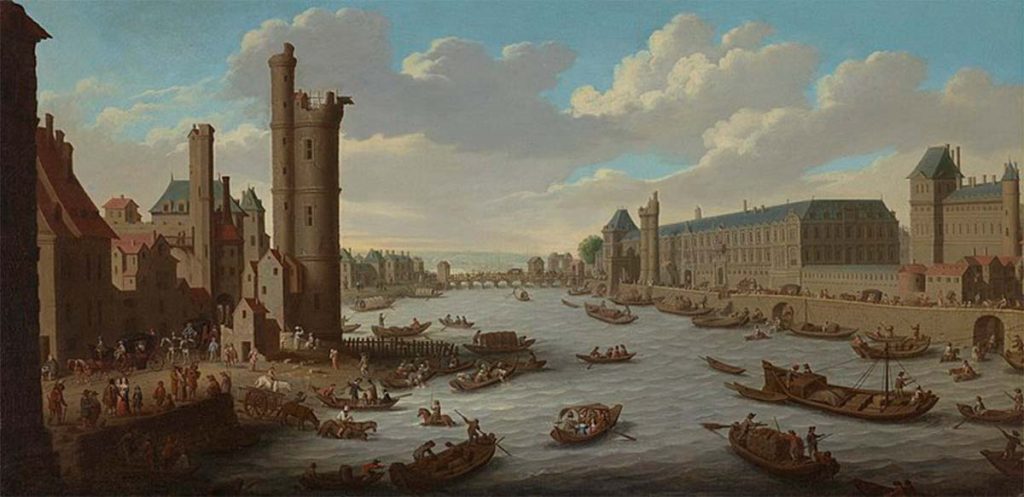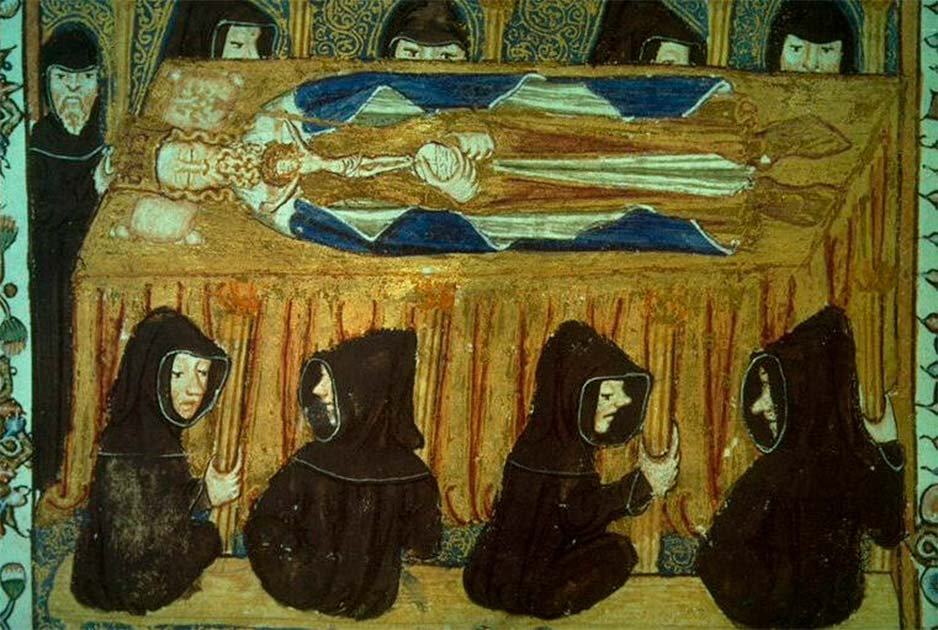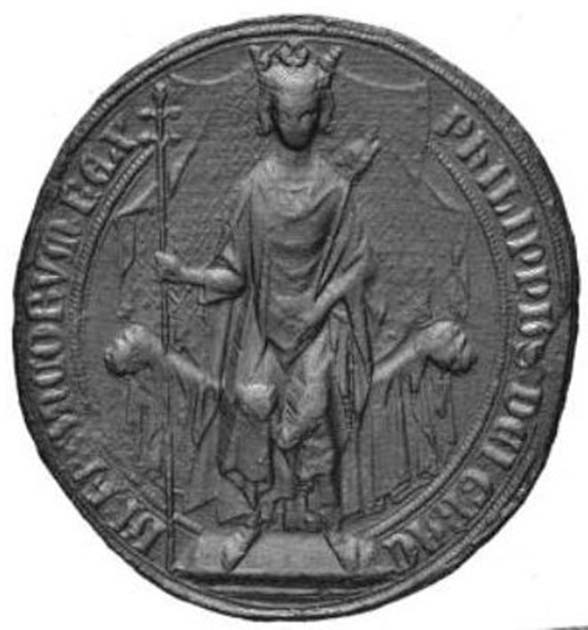Marriages in the past were arranged for political purposes when it came to nobility. Love was nice, but power and control were a whole lot nicer.
This meant that many members of the elite often found themselves in loveless marriages or were forced to marry a woman when (history suggests) they were likely homosexual or bisexual. In these politically driven marriages, it is no surprise to hear that extramarital affairs were prevalent.
One such affair led to the end of a noble family, a years-long succession crisis, and one of the most famous wars from early history. The Tour de Nesle Affair was unlike any affair in French history.
The Marriages of the House of Capet
Before delving into the events of the Tour de Nesle Affair, we need to meet the members of the House of Capet who were involved in this scandal. The House of Capet was the ruling family of the Kingdom of France from 987 to 1328.
In 1314, when the Tour de Nesle Affair occurred, the King of France was Philip IV. Philip IV had three sons: Louis (future Louis X), Philip (future Philip V), and Charles (future Charles IV), and one daughter named Isabella.
Isabella was married to King Edward II of England. She was known as the “She-Wolf of France” due to her formidable reputation as the Queen of England, and relied on her father for advice on many things, especially concerning issues with her marriage (King Edward II was incredibly close to his friend, Piers Gaveston, his possible lover).

Philip IV’s sons were married to foster alliances with Burgundy. Louis was married to Margaret of Burgundy; their marriage was said to have been unhappy, but they produced one child, Joan II of Navarre, in 1312.
Philip was married to Joan II, Countess of Burgundy, and the pair were said to be the happiest of all of the marriages. They had five children in a five-year time period, but their only son died in childhood.
Charles was married to Blanche of Burgundy (Joan’s sister). Their marriage was described as “unremarkable,” primarily due to Charles being incredibly boring, still, the couple had two children, but they both died young. These marriages based on political alliances were the foundation upon which the affair was established.
The Tour de Nesle Affair
In 1313, Isabella and King Edward II paid a visit to France, and while there, Isabella gave her sisters-in-law fancy custom embroidered silk purses as a gift. Once Isabella and Edward II returned to London, they hosted a large dinner, and the House of Capet came to the event.
During the feast, Isabella noticed that two of the Norman Knights who accompanied her father, brothers, and their wives were wearing two of the silk purses Isabella gave to her sisters-in-law. Isabella immediately came to the conclusion that an illicit affair was occurring. It is believed that Isabella told her father of her suspicions upon a second visit to France in 1314.
- The Tavora Executions: An Entire Noble Family Put to the Sword
- Crown Prince Rudolph And The Mayerling Incident: Suicide Or Murder?
Philip IV placed the two knights, Walter (aka Gautier) of Aunay, and Philip of Aunay, and his sons’ wives under surveillance, and the royal scandal began to form. Blanche and Margaret were accused of “eating, drinking, and engaging in adultery” with Gautier and Philip of Aunay in the Tour de Nesle.
This old guard tower in Paris located next to the river Seine which Philip IV purchased in 1308. It was here that the affairs had been clandestinely conducted.

After the surveillance was completed and the guilt confirmed, King Philip IV made a public announcement of the Tour de Nesle Affair and that Gautier and Philip of Aunay, Blanche, and Margaret had been arrested. There are some accounts that the knights attempted to abscond to England, but they were captured, interrogated, and tortured by French authorities.
Both men confessed to adultery which meant they were also guilty of a more dangerous crime, known as “lèse majesté”. Lèse majesté, or “a crime against the Crown,” is an offense against the dignity of a monarch or, today, a president or the state itself as an entity.
While this offense first developed during the Roman Republic, it is still a legitimate crime in many countries today. Insulting a political leader/monarch/foreign dignitary/desecrating a flag falls under the terms of lèse majesté in several c countries in Europe, Asia, Africa, the Middle East, and South America.
Gautier and Philip of Aunay were killed after confessing their guilt under torture. While the exact method of execution varies, historians agree that the men were castrated before being either flayed alive, broken on a wheel, and then hanged, or drawn and quartered.
Either way, the men were brutally and publicly executed, and this was so horrendous that it put King Philip IV into a state of shock, which many believe contributed to his death later that year. Margaret and Blanche were tried and found guilty of adultery and, as punishment, had their heads shaven and sentenced to life in prison.
Initially, Joan was accused of being present during the affair or potentially involved; however, with the support of her husband, Philip, she was only placed under house arrest for a year before being permitted to return to the royal court. She was tried before the Paris Parliament but was ruled innocent, which was essentially a result of her husband’s influence and support.
Blanche and Margaret were imprisoned in an underground jail at Chateau Gaillard. Blanche was likely pregnant with a son at the time of her arrest, and after spending eight years below ground, she died sometime around 1328.
After two years in prison, Margaret caught a cold and died. This was the downfall of the House of Capet, but not because of political scandal. What followed the Tour de Nesle Affair was a succession mess.
The Aftermath
When King Philip IV died as a result of shock from the execution of the two knights, it started a strange period of succession. Louis, the eldest brother, in order to succeed to the throne, needed to remarry as soon as possible.

Although she was in prison, Margaret was still legally married to Louis, but things turned out ok: she just happened to die five days before her husband, now known as King Louis X of France, married his second wife, Clementina of Hungary, in 1315. Rumors swirled that Louis had Margaret murdered to make his second marriage legal.
- Marguerite Alibert: Courtesan, Murderess and Blackmailer of a King
- When Women Ruled the Papacy: Marozia and the Pornocracy
Louis died in 1316 following a rousing game of tennis (yes, he died from over-exertion from playing tennis), but his new wife was eight months pregnant. If Clementina were to give birth to a son, he would be the new King of France.
But, if Clementina had a girl, the succession was at risk. Because Louis was still married to Margaret when she died, their daughter Jeanne would technically outrank a newborn princess.
Clementina gave birth to a son; however, he died five days after birth. This made Louis’s brother Philip the Royal Regent, and he wasted no time securing the crown for himself.
His niece, Jeanne’s, claim to the throne was weaker than Philip’s. Philip secured his throne by invoking a practically obsolete legal rule from the fifth century (known as Salic Law) that said that a man would inherit landed property while a woman would inherit personal property. Which meant a woman was unable to inherit the Crown.
This led to Philip becoming King Philip V; however, he was still married to Joan. Joan was only kept under house arrest for a year before being allowed to return to court, so she became the new Queen of France. In 1322, Philip became sick and died. The issue here was that because Philip had invoked the rule about inheritance and gender, his four daughters were unable to ascend the throne.
This meant that Charles then became King Charles IV of France. As the new king, Charles needed an heir, so he paid the Pope to annul his marriage to his wife, Blanche. The marriage was annulled on the condition that Blanche would be released from jail and sent to become a convent member.
Charles married a woman named Jeanne d’Évreux who fell pregnant by Charles. However, Charles died in 1328 before the child was born. Because he did not have a son from his marriage to Blanche, the fate of the French monarchy depended on the gender and survival of Charles’ widow’s child.
Charles was the last of Philip IV’s children and, thus, the last Capetian king unless a son was born. In the meantime, Charle’s nephew, Philip of Valois, was made the King Regent.

The House of Capet by this time appeared cursed because Jeanne gave birth to a baby girl. After a male heir could not be produced, the French Crown was up for grabs by Philip of Valois or King Philip IV’s grandson, Edward III, who was also heir to the English throne (the son of Isabella and Edward II).
The lords of the French nobility were totally against having the future King of England and the current King of England rule France, so they, too, invoked the Salic Law. Because Edward III was the son of Philip IV’s daughter, he had no claim to the French throne in part because his mother wasn’t allowed to become the Queen of France. This meant Philip of Valois was now King Philip VI of France.
The Hundred Years War
The Tour de Nesle Affair and the proceeding succession issues negatively impacted the relationship between France and England, which provoked the Hundred Years War. Edward III invaded France in 1337 to seek his claim to the French throne, thus recreating the Angevin Empire that his ancestor Henry II had formed back in 1154. The Hundred Years War continued on and off until 1435 and destroyed the French nobility, and left France in a state of severe economic devastation.
What is ironic about the Tour de Nesle Affair is that while Isabella lit the flame that was to become the affair and the succession crisis that led to the Hundred Years War, she also gained a reputation for being an adulteress. Isabella had a very public affair with the Earl of March, Roger Mortimer, and it is believed that Isabella might have had her husband, Edward II, murdered to stay with Mortimer. The Tour de Nesle Affair began with some silk purses and ended the entire Capetian line of Kings.
Top Image: The main players in the Tour de Nesle affair: Philip IV flanked by his sons Charles and Philip and his daughter Isabella on the left, and his eldest son and heir Louis and brother Charles on the right. Source: Unknown Author / Public Domain.